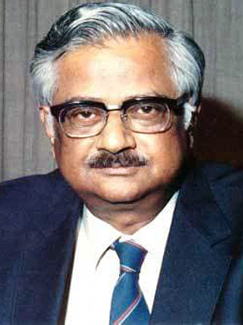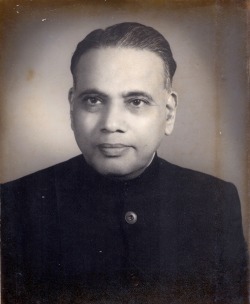
Nataraja, also known as Adalvallan, is a depiction of Shiva, one of the main deities in Hinduism, as the divine cosmic dancer. His dance is called the tandava. The pose and artwork are described in many Hindu texts such as the Tevaram and Thiruvasagam in Tamil and the Amshumadagama and Uttarakamika agama in Sanskrit and the Grantha texts. The dance murti featured in all major Hindu temples of Shaivism, and is a well-known sculptural symbol in India and popularly used as a symbol of Indian culture, as one of the finest illustrations of Hindu art. This form is also referred to as Kuththan, Sabesan, and Ambalavanan in various Tamil texts.

Raja Ramanna was an Indian physicist who is best known for his role in India's nuclear program during its early stages.

Homi Jehangir Bhabha, FNI, FASc, FRS, Hon.FRSE was an Indian nuclear physicist who is widely credited as the "father of the Indian nuclear programme". He was the founding director and professor of physics at the Tata Institute of Fundamental Research (TIFR), as well as the founding director of the Atomic Energy Establishment, Trombay (AEET) which was renamed the Bhabha Atomic Research Centre in his honour. TIFR and AEET served as the cornerstone of the Indian nuclear energy and weapons programme. He was the first chairman of the Indian Atomic Energy Commission and secretary of the Department of Atomic Energy. By supporting space science projects which initially derived their funding from the AEC, he played an important role in the birth of the Indian space programme.

Tata Institute of Fundamental Research (TIFR) is an Indian Research Institute under the Department of Atomic Energy of the Government of India. It is a public deemed university located at Navy Nagar, Colaba in Mumbai. It also has campus in Bangalore, International Centre for Theoretical Sciences (ICTS), and an affiliated campus in Serilingampally near Hyderabad. TIFR conducts research primarily in the natural sciences, the biological sciences and theoretical computer science.

Mambillikalathil Govind Kumar Menon also known as M. G. K. Menon, was a physicist and policy maker from India. He had a prominent role in the development of science and technology in India over four decades. One of his most important contributions was nurturing the Tata Institute of Fundamental Research, Mumbai, which his mentor Homi J. Bhabha founded in 1945.

Srikumar Banerjee was an Indian metallurgical engineer. He retired as the chairman of the Atomic Energy Commission of India (AECI) and the secretary of Department of Atomic Energy (DAE) on 30 April 2012. Prior to his stint as DAE chairman, he was the director of Bhabha Atomic Research Centre (BARC) from 30 April 2004 to 19 May 2010. He had also served as a DAE Homi Bhabha Chair Professor at Bhabha Atomic Research Centre, Mumbai. He was known as a great physical metallurgist.

VicitracittaCalambur Sivaramamurti FRAS (1909–1983) was an Indian museologist, art historian and epigraphist who is primarily known for his work as curator in the Government Museum, Chennai. and Sanskrit scholar. His entire life has been devoted to the study and exposition of various aspects of Indian art. Apart from authoring several monographs, guide books on Indian art, he also wrote a seminal work on South Indian epigraphy.

Madabusi Santanam Raghunathan FRS is an Indian mathematician. He is currently Head of the National Centre for Mathematics, Indian Institute of Technology, Mumbai. Formerly Professor of eminence at TIFR in Homi Bhabha Chair. Raghunathan received his PhD in Mathematics from (TIFR), University of Mumbai; his advisor was M. S. Narasimhan. Raghunathan is a Fellow of the Royal Society, of the Third World Academy of Sciences, and of the American Mathematical Society and a recipient of the civilian honour of Padma Bhushan. He has also been on the Mathematical Sciences jury for the Infosys Prize from 2016.
Padmanabhan Krishnagopala Iyengar, was an Indian nuclear physicist who is widely known for his central role in the development of the nuclear program of India. Iyengar previously served as the director of BARC and former chairman of the Atomic Energy Commission of India, he raised his voice and opposition against the nuclear agreement between India and the United States and expressed that the deal favoured the United States.

Bikash Sinha was an Indian physicist who was active in the fields of nuclear physics and high energy physics. Sinha was the director of the Saha Institute of Nuclear Physics and Variable Energy Cyclotron Centre and the chairman of the Board of Governors of the National Institute of Technology, Durgapur in June 2005. He was also a member of scientific advisory board to the Prime Minister of India.

Purushottam Kashinath Kelkar (1909-1990) was an Indian scientist who is best remembered for being the founding director of the Indian Institute of Technology Kanpur, which was established in 1959. He was also involved in the planning process for the establishment of the Indian Institute of Technology Mumbai and served as its third director, for a period of 4 years. Kelkar was instrumental in securing USA's technical collaboration in the establishment of IIT Kanpur, by persuading the then USA ambassador, John Kenneth Galbraith to locate the fledgeling institution on the outskirts of Kanpur, in North India. The Government of India awarded him the civilian honour of Padma Bhushan in 1970.
Ranjan Roy Daniel was an Indian Nagercoil born physicist who worked in the fields of cosmic rays and space physics, and remained Director Chairman of Tata Institute of Fundamental Research. He also served as an advisor to the prime minister of India, Indira Gandhi in 1976. He worked in the field of cosmic rays with Homi Jehangir Bhabha for 23 years.

Malur Ramasamy Srinivasan, is an Indian nuclear scientist and mechanical engineer. He played a key role in the development of India's nuclear power programme and the development of the PHWR. He received the Padma Vibhushan Award.

Jyeshtharaj Bhalchandra Joshi is an Indian chemical engineer, nuclear scientist, consultant and professor, widely known for his innovations in nuclear reactor designs and generally regarded as a respected teacher. He is the DAE-Homi Bhabha Chair Professor, Homi Bhabha National Institute, Mumbai, and is the recipient of Shantiswarup Bhatnagar Prize for Engineering Sciences and many other awards and recognitions. He received the third highest civilian honour, the Padma Bhushan, in 2014 for his services to the field of chemical engineering and nuclear science.
Shashikumar Madhusudan Chitre FNA, FASc, FNASc, FRAS was an Indian mathematician and astrophysicist, known for his research in Astronomy and Astrophysics. The Government of India honored him, in 2012, with Padma Bhushan, the third highest civilian award, for his services to the sciences.

National Institute of Advanced Studies (NIAS) is a premier institute in India engaged in interdisciplinary and multidisciplinary research in natural sciences, social sciences, arts and humanities. It was founded by J. R. D. Tata for providing an avenue for administrators, managers and social leaders for interaction and exchange of information with notable academics in the areas of science, arts and humanities. With these objectives, the institute conducts multi-level research programmes and mentors talented doctoral students. The institution, based in Bengaluru, in the south Indian state of Karnataka, started functioning on 20 June 1988 with Dr. Raja Ramanna as its founder director.
Badanaval Venkatasubba Sreekantan was an Indian high-energy astrophysicist and a former associate of Homi J. Bhabha at the Tata Institute of Fundamental Research (TIFR). He was also a Dr. S. Radhakrishnan Visiting Professor at the National Institute of Advanced Studies, Bangalore.

Vaidyeswaran Rajaraman is an Indian engineer, academic and writer, known for his pioneering efforts in the field of Computer Science Education in India. He is credited with the establishment of the first academic program in computer science in India, which he helped initiate at the Indian Institute of Technology, Kanpur in 1965. An elected fellow of all the Indian science academies, he is a recipient of Shanti Swarup Bhatnagar Prize, the highest Indian award in Science and Technology category for young scientists and several other honors including Om Prakash Bhasin Award and Homi Bhabha Prize. The Government of India awarded him the third highest civilian honor of the Padma Bhushan, in 1998, for his contributions to science.

Dipankar Chatterji is an Indian molecular biologist and the Honorary Professor at Molecular Biophysics Unit, Indian Institute of Science, a multidisciplinary research institute under the Department of Science and Technology of the Government of India. He is known for his pioneering research on bacterial transcription. He is a recipient of Shanti Swarup Bhatnagar Prize and is an elected fellow of all the major Indian science academies. The Government of India awarded him the fourth highest civilian honour of the Padma Shri, in 2016, for his contributions to science and engineering.
Chokkanathapuram Venkataraman Sundaram was an Indian chemical metallurgist, best known for the commissioning of the Fast Breeder Test Reactor at Kalpakkam. He was the director of the Indira Gandhi Centre for Atomic Research (IGCAR). He was a recipient of the Sanjay Gandhi Award for Science and Technology as well as the National Metallurgists Day Award and an elected fellow of the Indian National Science Academy, the Indian Academy of Sciences and the Indian National Academy of Engineering. The Government of India awarded him the Padma Bhushan, the third highest civilian award, in 1986.















